2.8.1 Simple Indole Alkaloids
L-Tryptophan (i.e., a-aminoindole-3-propanoic acid) on decarboxylation yields tryptamine. The Nmethyl and N, N-dimethyl derivatives of the latter are broadly distributed in the plant kingdom as serotonin—a simple hydroxylated derivative. Sequential biotransformation viz., decarboxylation,
N-methylation and hydroxylation gives rise to the formation of psilocin; whereas, phosphorylation of the OH group in psilocin yields psilocybin.
The three alkaloids, namely: serotonin, psilocin and psilocybin shall be discussed in the sections that follow:
A. Serotonin
Synonyms 5-Hydroxytryptamine; 5-HT; Enteramine; Thrombocytin; Thrombotonin;
Biological Sources The root bark of Gossypium hirsutum L. (Malvaceae) (American Unplanted
Cotton) contains serotonin.
Chemical Structure
3-(2-Aminoethyl)-1H-indol-5-ol; (C10H12N2O).
Identification Tests
1. Serotonin Hydrochloride (C10H12N2O.HCl) It is obtained as hygroscopic crystals, sensitive to light having mp 167-168°C. It is water soluble and the aqueous solutions are found to be stable at pH 2-6.4.
2. Serotonin complex with Creatinine Sulphate Monohydrate (C14H21 N5O6S.H2O)
(Antemovis) It is obtained as plates which decomposes at 215°C. Its uvmax (water at pH 3.5): is 275 nm (ε 15,000). It has two dissociation constants pK1' = 4.9 and pK2' = 9.8. The pH of a 0.01 molar aqueous solution is 3.6. It is found to be soluble in glacial acetic acid; very sparingly soluble in methanol and ethanol (95%); and insoluble in absolute ethanol, acetone, pyridine, ethyl acetate, chloroform, benzene and ether.
Uses
1. It is a potent vasoconstrictor.
2. It is also a neurotransmitter in the CNS and is important in sleep-walking-cycles.
B. Psilocin
Synonyms Psilocyn.
Biological Sources It is obtained from the sacred mushroom of Mexico known as Teonanacatl. It is also found in the fruiting bodies of Psilocybe maxicana Heim, (Agaricaceae).
Chemical Structure
3-[2-(Dimethylamino) ethyl]-1H-indol-4-ol; (C12H16N2O);
Isolation It has been successfully isolated in trace amounts from the fruiting bodies of Psilocybe mexicana*.
Characteristic Features
1. It is obtained as plates from methanol having mp 173–176°C.
2. It is an amphoteric substance.
3. It is unstable in solution, more precisely in an alkaline solution.
4. It is very slightly soluble in water.
5. Its uvmax: 222, 260, 267, 283, 293 nm (log ε 4.6, 3.7, 3.8, 3.7, 3.6).
Uses It is a hallucinogenic substance
Note It is a controlled substance listed in the U.S. Code of Federal Regulations, Title 21 Part 1308, 11 (1995).
C. Psilocybin
Synonym Indocybin;
Biological Sources These are same as mentioned in psilocin ‘B’ above.
Chemical Structure
3-[2-(Dimethylamino) ethyl]-1H-indol-4-ol dihydrogen phosphate ester; (C12H17N2O4P).
Isolation The method of isolation of psilocybin is the same as stated under psilocin.
Characteristic Features
1. Psilocybin is obtained as crystals from boiling water having mp 220-228°C; and from boiling methanol mp 185-195°C.
2. It has uvmax (methanol): 220, 267, 290 nm (log ε 4.6, 3.8, 3.6).
3. The pH of a saturated solution in 50% aqueous ethanol is 5.2.
4. Solubility Profile: It is soluble in 20 parts of boiling water, 120-parts of boiling methanol; sparingly soluble in ethanol; and practically insoluble in chloroform, benzene.
Uses It is a hallucinogenic substance and exerts its action at a dose level of 6-20 mg.
Biosynthesis of Serotonin, Psilocin and Psilocybin The different steps involved in the biosynthesis of serotonin, psilocin and psilocybin may be summarized as stated below:
1. L-Tryptophan upon oxidation gives rise to the corresponding hydroxylated derivative known as 5-hydroxyl-L-tryptophan, which further undergoes decarboxylation to yield serotonin also termed as 5-hydroxytryptamine (or 5-HT).
2. L-Tryptophan undergoes decarboxylation to yield the tryptamine, which affords N-Methylation and N,N-dimethylation in the presence of S-adenosylmethionine (SAM). The resulting dimethyl derivative upon oxidation gives rise to the product psilocin another hydroxylated derivative.
3. Phosphorylation of the hydroxyl function in psilocin affords psilocybin.
4. Interestingly, both psilocin and psilocybin are solely responsible for attributing the hallucinogenic properties of the so-called ‘magic mushrooms’, that include species of Psilocybe, Panaeolus and the like.
* Hofmann et al., Experientia, 14, 107 (1958); Heim et al., Helv. Chim. Acta, 42, 1557 (1959).
Source:Pharmacognosy And Pharmacobiotechnology By Ashutosh Kar
Source:Pharmacognosy And Pharmacobiotechnology By Ashutosh Kar

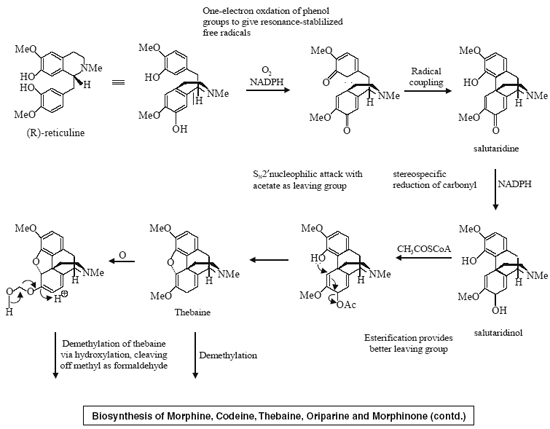
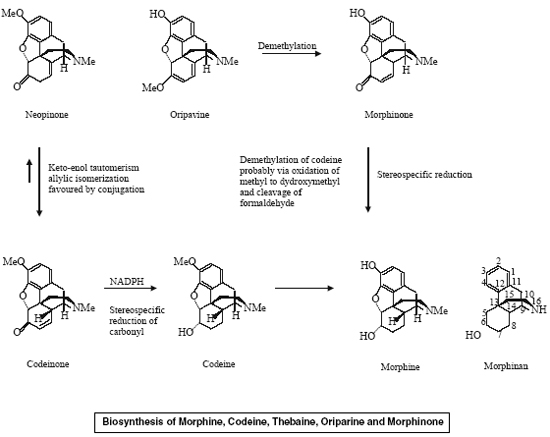

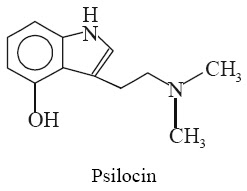
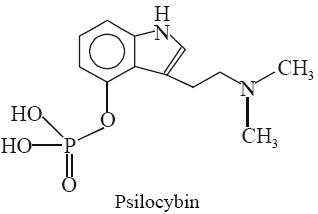
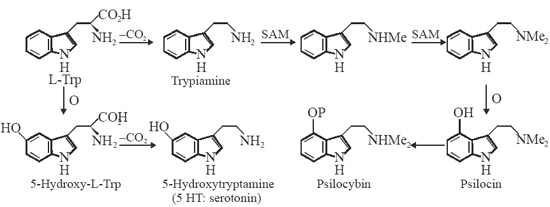

0 Comment:
Post a Comment